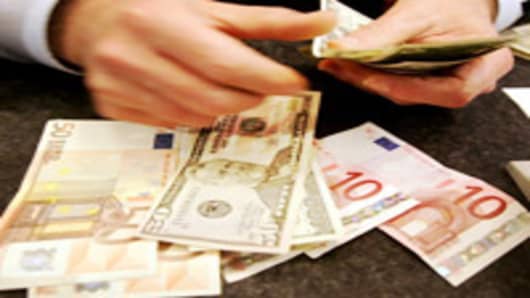The dollar fell on Friday and was set for its steepest weekly slide against a basket of major currencies in two months, as record high oil prices left the U.S. economy vulnerable to slower growth and rising inflation.
The euro , by contrast, remained on a solid footing despite data showing tepid growth in the euro zone's services and manufacturing sectors. Analysts said that despite the slowdown, the economy was robust enough to allow the European Central Bank to focus on restraining price pressures.
"We had a massive shift generally in the past couple of weeks and the market now sees the ECB hiking rates," said Marcus Hettinger, FX strategist at Credit Suisse in Zurich.
"Consumers in the U.S. are already under stress from housing, and now...we have rising oil prices. Basically it means interest rates will remain low in the U.S. despite rising inflation...and that's one of the reason why the dollar will remain weak," Hettinger said.
Against a basket of six major currencies, the dollar was down 1.2 percent on the week. If that holds, it would be its biggest weekly decline since late March.
The euro was up 0.3 percent at $1.5780 , off a one-month high of $1.5814 touched on Thursday. On the week, it rose 1.2 percent, the most since March. The dollar fell 0.8 percent to 103.20 yen .
Volume on Friday was light, with both the United States and Britain heading into long holiday weekends. A report showing sales of existing U.S. homes last month were slightly higher than expected offered little lasting dollar support, as the data showed the lowest April sales total since April 2000.
Earlier this week, the Federal Reserve said the slumping U.S. housing market likely had further to fall and also downgraded its 2008 U.S. economic growth outlook.
But with oil prices surging above $135 this week, markets have all but priced out the chances of another Fed rate cut this year, though a rate increase may be a tough sell at a time when U.S. growth is slowing.
"For the moment, the focus is on the stagflationary influences of oil, which is prone to play moderately negative for the dollar," said Alan Ruskin, chief international strategist at RBS Greenwich Capital in Greenwich, Connecticut. He said the euro could push above $1.60 in the third quarter.
Meanwhile, a flurry of strong data on inflation and business sentiment from the euro zone has left markets thinking the European Central Bank's next move may be an interest rate hike, and that's tilted sentiment in favor of the euro.
Lower-than-expected euro zone manufacturing and services data "confirm that the underlying growth trend in the euro zone economy is firmly down and that growth in the second quarter indeed will be less flattering," ING said in a note.
"However, the activity data are not yet weak enough to dilute the ECB's concerns about the medium-term inflation outlook, which is the primary factor driving its monetary policy decisions."
The low-yielding yen was a strong performer heading into the long weekend, with the euro down 0.5 percent at 162.82 yen.
Although Japan is vulnerable to higher oil costs, the impact on global growth also sparked risk-averse investors to unwind risky trades funded with cheaply borrowed yen. Nominal Japanese interest rates stand at just 0.5 percent, the lowest in the developed world.
U.S. and UK holidays on Monday also encouraged investors to scale back on risk heading into the long weekend, boosting the yen and low-yielding Swiss franc.


